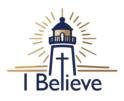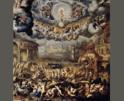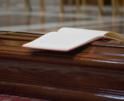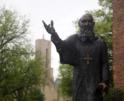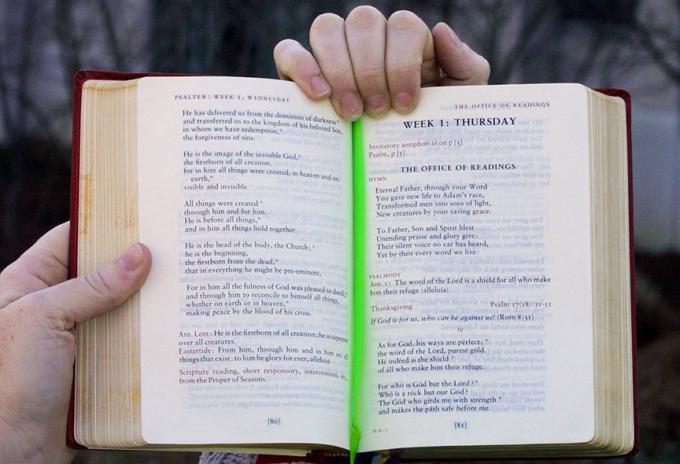
Faith
The Gospels tell us that Jesus, ever the observant Jew, followed this pattern of prayer. And following their Lord's example, the early church, as we read in the Acts of the Apostles, took up this pattern, as well.
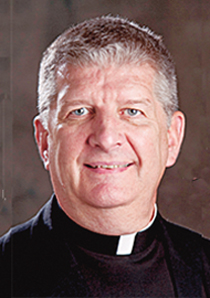
O’Grady
Worshiping the Father, through the Son, in the Holy Spirit is the foremost duty of the church. It is the distinguishing characteristic of Catholic Christians individually and together. A poignant reminder of this is the four volumes (in the U.S. version) of the Liturgy of the Hours, sometimes called the Divine Office, and once called the Breviary.
The complete reform of the Breviary directed by the Second Vatican Council was accomplished with the 1970 publication of the official Latin texts of the Liturgy of the Hours and the accompanying papal constitution, "Laudis canticum," and the General Instruction on the Liturgy of Hours. The work of the translators began, and an English version was released in 1975. A revised English version is being reviewed by the U.S. Conference of Catholic Bishops. It is a lengthy process, more than a decade from start to finish. And if all the pages of the consultation documents were printed out and delivered at once to a bishop, he'd get a case of paper! Happily, it's all available electronically to them and any consultors they choose to involve.
The pattern set for this book has roots deep in Israel. In both Old and New Testaments, we hear that the chosen people stopped and prayed at specific times of the day. They did this alone, as family, or gathered together in a synagogue or temple.
The Gospels tell us that Jesus, ever the observant Jew, followed this pattern of prayer. And following their Lord's example, the early church, as we read in the Acts of the Apostles, took up this pattern, as well.
In subsequent ages of the church's life, the pattern continued while the church was in the catacombs and then when she was able to worship freely and publicly. Slowly, both in the east and the west, the shape of today's Liturgy of the Hours developed.
There are all kinds of prayers in this liturgy. Psalms, canticles, hymns, antiphons, responsories, intercessions, collects, doxologies, the Lord's Prayer, blessings, and dismissals.
These are all arranged in various hours. Lauds or morning prayer, and vespers or evening prayer are the "hinges" or more important hours; the office of readings, and compline, and then midday prayer, which has three options, mid-morning, mid-day, midafternoon.
The various kinds of prayers are selected to match the hours when they are prayed.
The psalms are the center of the Liturgy of the Hours. Almost all 150 of them are spread over the four-week cycle. In addition to prayers, there are biblical readings from both Old and New Testaments (some are as brief as a sentence), and there are readings from the church's vast library of spirituality, theology, homilies, and biography.
While most often the Liturgy of the Hours is celebrated individually (it is required daily for bishops, priests, and deacons), it is also celebrated communally and "in choir" in monasteries of women and men religious.
This prayer is not the exclusive possession of the clergy or religious, it belongs to the whole church.
Happily, some parishes celebrate some of the Liturgy of the Hours at least occasionally, some quite regularly. Many parishes will celebrate the appropriate hours during the Sacred Triduum at the end of Holy Week, just before Easter.
Admittedly, the Liturgy of the Hours is complicated to use. It takes practice. And an observer would wonder why all the turning of pages and shifting of ribbons. This is becoming less of an issue with the use of electronic versions of the Liturgy of the Hours.
There is a story that circulates about a German publisher who thought the idea of the pope having to flip pages and change ribbons decided to print the old Breviary in a format that permitted the Venerable Pope Pius XII to read his Breviary starting at page one and going to the end. It was bound in white leather with his coat of arms on it -- not easy to lose or, for members of the Roman Curia, to borrow. I have never been able to determine if this was real, or how many volumes and total pages it would have included. My bet is certainly more than our four!
One of the hopes of the Fathers of Vatican II was that this prayer would expand beyond clergy and religious. This is being realized in many parishes, as noted above, but there are also many excellent participation aids for individuals, families, and groups.
Some of you may subscribe to Magnificat or Give Us This Day, or use an app such as Divine Office or Universalis. You are already praying the Liturgy of the Hours.
With the whole church, you are praying always.
Recent articles in the Faith & Family section
-
Speak, Lord!Archbishop Richard G. Henning
-
Heads upScott Hahn
-
America, In the Power of the Spirit, Witnesses to ChristMaureen Crowley Heil
-
Liturgical music for funeral liturgiesRichard J. Clark
-
Scripture Reflection for Dec. 1, 2024, First Sunday in AdventFather Joshua J. Whitfield

